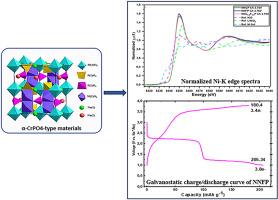钠离子插入中熵Na2-uNi2+2-xNi3+x(Cr3+1-yCr4+y)1-wFe3+w(PO4)3阴极的结构和光谱研究
IF 3.5
3区 化学
Q2 CHEMISTRY, INORGANIC & NUCLEAR
引用次数: 0
摘要
α- crpo4型结构的中熵磷酸盐正极材料具有良好的na离子插入潜力。采用改进的Pechini法合成了fe取代的Na2-uNi2+2-xNi3+x(Cr3+1- ycr4 +y)1- wfe3 +w(PO4)3(其中u = x +y, w = 0,0.5, 1)。x射线衍射图的Rietveld细化证实了Na1.7Ni2+1.9Ni3+0.1Cr3+0.8Cr4+0.2(PO4)3、Na1.6Ni2+1.7Ni3+0.3Cr3+0.4Cr4+0.1Fe3+0.5(PO4)3和Na1.8Ni2+1.8Ni3+0.2 fe3 +(PO4)3的化学计量。虽然结构类似于α-Na2Ni2Fe(PO4)3,但这些材料显示出不同的原子位置坐标和占位,过渡金属M(1)和M(2) (M = Fe, Ni, Cr)在4a和8g位点上统计上无序。在1.00-3.75 V vs. Na+/Na的中等电压范围内评价了电化学性能。由于初始钠含量较低,4b位点和4c位点部分被占据,第一次放电循环的比容量分别为165.8、188.9和205.34 mA h g−1,可逆性分别为80.1、84.1和90%。非原位x射线衍射图、x射线光电子能谱以及Cr和Ni-K边缘x射线吸收近边结构分析证实了na离子插入反应的发生,排除了转化反应的可能。材料表现出可逆的多电子反应,在保持结构的同时适度激活Cr4+/Cr3+/Cr2+、Fe3+/Fe2+/Fe0和Ni3+/Ni2+/Ni0氧化还原对。最终,铁取代有效地抑制了相变,增强了结构的可逆性。本文章由计算机程序翻译,如有差异,请以英文原文为准。

Structural and spectroscopic insights of medium-entropy Na2-uNi2+2-xNi3+x(Cr3+1-yCr4+y)1-wFe3+w(PO4)3 cathodes with sodium-ion insertion
Medium-entropy phosphate cathode materials with an α-CrPO4-type structure exhibit promising potential for Na-ion insertion. Fe-substituted Na2-uNi2+2-xNi3+x(Cr3+1-yCr4+y)1-wFe3+w(PO4)3 (where u = x + y and w = 0, 0.5, and 1) were synthesized via a modified Pechini method. Rietveld refinement of the X-ray diffraction patterns confirmed the stoichiometries Na1.7Ni2+1.9Ni3+0.1Cr3+0.8Cr4+0.2(PO4)3, Na1.6Ni2+1.7Ni3+0.3Cr3+0.4Cr4+0.1Fe3+0.5(PO4)3 and Na1.8Ni2+1.8Ni3+0.2Fe3+(PO4)3. Although structurally similar to the α-Na2Ni2Fe(PO4)3, these materials display distinct atomic site coordinates and occupancies, with transition metals M(1) and M(2) (M = Fe, Ni, Cr) statistically disordered across 4a and 8g sites. Electrochemical performance was evaluated within a moderate voltage range of 1.00–3.75 V vs. Na+/Na. Due to the initially low sodium content, with partial occupation of 4b sites and empty 4c sites, the first discharge cycle yielded specific capacities of 165.8, 188.9, and 205.34 mA h g−1, with reversibility rates of 80.1, 84.1, and 90 %, respectively. Ex-situ X-ray diffraction patterns, X-ray photoelectron spectroscopy, and Cr and Ni–K edge X-ray absorption near edge structure analyses confirmed the occurrence of Na-ion insertion reactions, ruling out conversion reaction. The materials demonstrated reversible multi-electron reactions involving moderate activation of Cr4+/Cr3+/Cr2+, Fe3+/Fe2+/Fe0, and Ni3+/Ni2+/Ni0 redox couples while preserving the structure. Ultimately, Fe substitution effectively suppressed phase transitions and enhanced structural reversibility.
求助全文
通过发布文献求助,成功后即可免费获取论文全文。
去求助
来源期刊

Journal of Solid State Chemistry
化学-无机化学与核化学
CiteScore
6.00
自引率
9.10%
发文量
848
审稿时长
25 days
期刊介绍:
Covering major developments in the field of solid state chemistry and related areas such as ceramics and amorphous materials, the Journal of Solid State Chemistry features studies of chemical, structural, thermodynamic, electronic, magnetic, and optical properties and processes in solids.
 求助内容:
求助内容: 应助结果提醒方式:
应助结果提醒方式:


